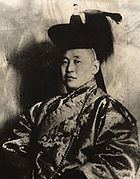 | ||
Tumi amar noyan go
Noyon, noyan, nayan (and some other spellings introduced via Arabic texts; Mongolian: ноён) was a title of authority in the Mongol Empire and later periods. In modern Mongolic the word is used as a form of address similar to "Mister" or "Monsieur".
Contents
Initially, it was a term for a military commander in the army of Genghis Khan: the term noyon applied to commanders of tumens and mingghans, military units of 10,000 and 1,000 soldiers respectively. During conquests, noyons used to receive territories for administration and they effectively became aristocracy, into the 20th century. Noyans were above the ordinary Mongols in social rank but below the descendants of Genghis and his brothers. They were sometimes called emir or bey in the Ulus of Jochi, the Ilkhanate and the Chagatai Khanate while the Yuan records gave the equivalent as guanren, since their main task was waging warfare.
Usually notable persons are referred to followed "Noyan", similarly to the usage of the title "Khan", e.g., Jebe Noyan, Chormaqan Noyan, Sali Noyan and Karik Noyan.
After the Mongol Empire
The Qing Dynasty, which ruled Mongolia from 1694 to 1911, entrusted rule in Mongolia to the descendants of Genghis Khan, who were also called noyon. The term noyon in this epoch acquired the connotation of nobleman, since Mongolia was mostly at peace. After 1921 the word darga (boss) replaced the aristocratic noyon as the term for officials.
Many noyons were executed and/or arrested during the Great Purge in Mongolia.
